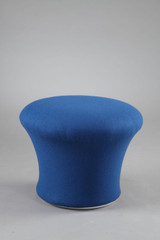The "Mushroom" set comprises an armchair and matching ottoman with a metal tube frame upholstered in polyurethane foam. The set has been reupholstered in blue wool crepe fabric. The armchair, with its rounded shape and sensual feel, offers a comfortable and plush seat. Produced by Artifort.
Pierre Paulin (Paris, 1927 – Montpellier, 2009) has been a leading figure in French design for half a century, renowned for his sleek and sensual armchairs. His mushroom- or tongue-shaped seats, upholstered in yellow, orange, pink, or purple jersey, have become world-famous. Today, they grace the collections of the MoMA in New York, the Musée des Arts Décoratifs in Paris, the Victoria and Albert Museum in London, and the museums of Sydney and Melbourne in Australia. Influenced by Scandinavian furniture, Japanese minimalism, and the American designs of Charles and Ray Eames, Pierre Paulin chose to create simple, functional, durable, and affordable furniture, characteristic of the post-war era. While his creations were part of an industrial approach that took into account the economic and sociological realities of the time, his bold ideas have often been adopted by subsequent generations. Better known abroad than in France throughout his career, he nevertheless exhibited at the Salon des Arts Ménagers (Household Arts Fair) as early as 1953. In the 1960s, Pierre Paulin molded the shells of his chairs in jersey or stretch fabric, concealing their structures and delivering seamless, rigorous, sensual, and comfortable seating. He notably created the "Ruban" armchair with its sculptural base, upholstered in zebra or panther print fabric, as well as the Champignon (Mushroom) and Amphis, nicknamed "the sausage," whose seat meanders. A longtime collaborator with the industrial design agency AD SA, he founded the Pierre Paulin company in 1979, where he worked as part of a team on industrial design for brands such as Calor, Tefal, and PSA. Bibliography: A. Chapoutot, "Pierre Paulin. Un univers de formes" (Pierre Paulin. A Universe of Forms), Paris, Du May, 1992. A similar model is reproduced in color on page 38. Design Era, Circa: 1963
- Reference :
- 1616
- Availability :
- Sold
- Identify Exists:
- False


























